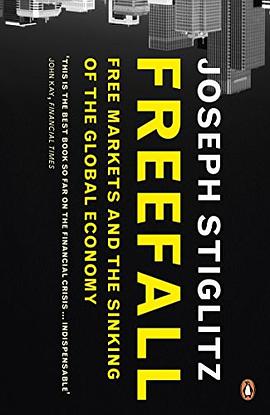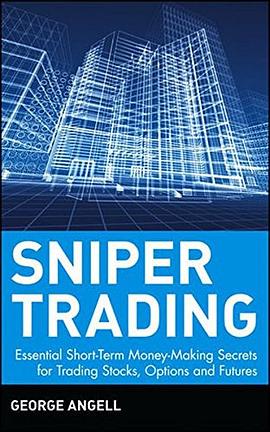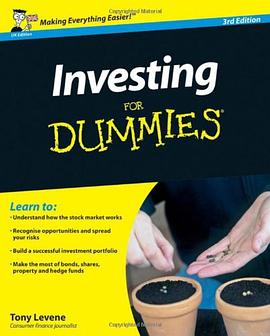

具体描述
在过去30年间,金融业发生了翻天覆地的变化,其标志是创新、全球化和放松管制。作者写作本书的目的就是帮助学生了解金融业的巨大变化。和其他教科书相比,本书有其自身的特点:一是取材广泛,从机构到市场、工具,如资产的证券化、抵押市场等等,这些是其他教材没有或不够深入的。二是内容全面、资料新,给学生大量的信息和分析工具,并且详细描绘了一些大型市场与机构的运行、结构和规章制度,使学生能够学会分析金融业的某些全
作者简介
目录信息
Partl INTRODUCTION
Introduction
Financial Intermediaries
and Financial Innovation
The Role of the Government
in Financial Markets
Part 11 DEPOSITORY INSTITUTIONS
Chdpter 4 Depository Institutions: Activities
and Characteristics
Chapter 5 Central Banks and the Creation
of Money
Chapter 6 Monetary Policy
Part 111 NON-DEPOSITORY FINANCIAL
INTERMEDIARIES
Chapter 7 Insurance Companies
Chapter 8 Investment Companies
Chapter 9 Pension Funds
Part IV DETERMINANTS OF ASSET PRICES
AND INTEREST RATES
Properties and Pricing
of Financial Assets
The Level and Structure
of Interest Rates
The Term Structure
of Interest Rates
Risk/Rcturn and Asset
Pricing Models
Part V ORGANIZATION AND STRUCTURE
OF MARKETS
Chapter 14 Primary Markets and the
Underwriting of Securities
Secondary Markets
Part Vl MARKETS FOR GOVERNMENT
DEBT
Chapter 16 Treasury and Agency Securities
Markets
Chapter 17 Municipal Securities Markets
Part Vll MARKETS FOR CORPORATE
SECURITIES
Chapter 18 Common Stock Markets
in the United States
Chapter 19 Stock Markets around the World
Chapter 20 Markets for Corporate Senior
Instruments: 1
Chapter 21 Corporate Senior Instmments: 11
Chdpter 22 The Markets for Bank Obligations
Part Vlll MORTGAGE AND SECURITIZED
ASSET MARKETS
Chdpter 23 The Mortgage Market
Chdpter 24 Mortgage-Backed Securities
Market
Chdpter 25 Asset-Backed Securities Market
Part IX MARKETS FOR DERIVATIVE
SECURITIES
Chdpter 26
Chdpter 27
Chdpter 28
Chdpter 29
Chdpter 30
Chdpter31
Index
Financial Futures Markets
Options Markets
Pricing of Futures and Options
Contracts
The Applications of Futures
and Options Contracts
Interest Rate Swap and Interest Rate
Agreement Market
The Market for Foreign Exchange
Rate Risk Control Instruments
Preface xv
Acknowledgments xuiii
Biographical Sketches xx
Part 1 INTRODUCTION
Chapter 1 Introduction
Financial Assets
Debt versus Equity Claims 3 The Price of a Financial Asset and Risk 3 *
Financial Assets versus Tangible Assets 4 The Role of Financial Assets 4
Financial Markets
Role of Finandal Markets 6 CIassification of Financial Markets 6
Market Participants
Globalization of Financial Markets
Classification of Global Finandal Markets 9 Motivation for Using Foreign
Markets and Euromarkets
Derivative Markets
Types of Derivative Instruments 11 The Role of Derivative Instruments
Summary
Chapter 2 Financial Intermediaries and Financial Innovation
Financial Institutions
Role of Financial Intermediaries
Maturity Intermediation 20 Reducing Risk via Diversification 20 *
Reducing the Cost ofContracting and Information Processing 21 Providing
a Payments Mechanism
Overview of Asset/Liability Management for Financial Institutions
Nature of Liabilities 23 Liquidity Concerns 24 Regulations and Taxation
Financial Innovation
Categorizations of Financial Innovation 25 Motivation
for Financial Innovation
Asset Securitization as a Financial Innovation
Benefits to Issuers 28 Benefits to Investors 29 Benefits to Borrowers 29
Implications of Securitization for Financial Markets 29 Social Benefits 30
Summary
Chapter 3 The Role of the Govemment in Financial Markets
Purposes and Forms of Regulation
Justification for Regulation 35 An Introduction to Forms of Regulation 36
Regulation in the United States
Regulation in Japan
Regulation in Germany
Regulation in the United Kingdom
Regulatory Refonn
Summary
Part 11 DEPOSITORY INSTITUTIONS
Chapter 4 Depository Institutions: Activities and Characteristics
Asset/Liability Problem of Depository Institutions
Interest Rate Risk 54 Liquidity Concerns
Commercial Banks
Bank Services 61 Bank Funding 62 Regulation
�avings and Loan Associations
Assets 72 Funding 74 Regulation 74 The S&L Crisis
Savings Banks
Credit Unions
Summary
Chapter 5 Central Banks and the Creation of Money
The Central Bank and Money Creation in the United States
The Central Bank of the United States: The Federal Reserve System 85
Instruments of Monetary Policy: How the Fed Influences the Supply of Money 86
?Different Kinds of Money 89 Money and Monetary Aggregates 89 The Money
Multiplier: The Expansion of the Money Supply 91 The Impact of Interest Rates
on the Money Supply 93 The Money Supply Process in an Open Economy 94
The Central Banks of Other Countries
Germany 96 Japan 97 United Kingdom
Summary
Chapter 6 Monetary Policy
Monetary Policy in the United States
Goals of Monetary Policy 103 Trade-Offs and Conflicts among Polides 108
Goals and Types of Targets 108 Choosing the Operating Target 109 Choosing
the Intermediate Target 110 A Review of Recent Federal Reserve Policy
Goals and Targets of Monetary Policy in Other Economies
Germany l6 Japan 117United Kingdom
Summary
Part 111 NON-DEPOSITORY FINANCIAL INTERMEDIARIES
Chapter 7 Insurance Companies
Fundamental Characteristics of the Insurance Industry
Insurance Policy and Premiums 123 Surplus and Reserves 124 Determination
of Profits 124 Government Guarantees 125 Regulation 125
Life Insurance Companies
Liabilities and Liability Risk 127 Types of Policies 127 Investments
Property and Casualty Insurance Companies
Nature of the Liabilities 131 Investments
Financial Trends in the Intemational Insurance Industry
Bancassurance 133 Cross-Border Activities 134 Pension Funds
and Insurance Companies
Summary
Chapter 8 Investment Companies
Types of Investment Companies
Open-End Funds 140 Closed-End Funds 141 Unit Trusts 143
Structure and Expenses of a Fund
Types of Funds by Investment Objective
Economic Motivation for Funds
Regulation of Funds
Commercial Banks and Mutual Funds
The Concept of a Family of Funds
Industry Concentration
Mutual Funds in Other Economies
United Kingdom 151 �ermany I53 Japan 154
Summary
Chapter 9 Pension Funds
Introduction to Pension Plans
Types of Pension Plans
Defined Contribution Plan 161 Defined Benefit Plan 162 Hybrid
Pension Plans 162
Investments
Regulation
Managers of Pension Funds
Pension Funds in Other Countries
Germany 166United Kingdom 167 Japan 168
Summary
Appendix: Endowment Funds
Part IV DETERMINANTS OF ASSET PRICES AND INTEREST RATES
Chapter 10 Properties and Pricing of Financial Assets
Properties of Financial Assets
Moneyness 174 Divisibility and Denomination 174 Reversibility 174 Cash
Flow 175 Term to Maturity 176 Convertibility 176 Currency 176 Liquidity
177 Return Predictability 177 Complexity 178 Tax Status 179
Principles of Pricing Financial Assets
The Appropriate Discount Rate 180 Illustration 180 Price
and Asset Properties
Price Volatility of Financial Assets
The Effect of Maturity 184 The Effect of the Coupon Rate 184 The Effect of
the Level of Yields 186 Measuring Price Sensitivity to Interest Rate
Changes: Duration
Summary
Appendix: Review of Present Value
Chapter 11 The Level and Structure of Interest Rates
The Theory of Interest Rates
Fisher's Classical Approach 199 The Loanable Funds Theory 203
The Liquidity Preference Theory 204 Changes in the Money Supply
and Interest Rates
The Determinants of the Structure of Interest Rates
Features of a Bond 208 Yield on a Bond 209 The Base Interest Rate 212
The Risk Premium 212
Summary
Chapter 12 The Term Structure of Interest Rates
The Yield Curve and the Term Structure
Using the Yield Curve to Price a Bond 225 Constructing the Theoretical Spot
Rate Curve 226 Using Spot Rates to Value a Bond 229
Forward Rates
Other Forward Rates 233 Relationship between Spot Rates and Short-Term
Forward Rates 234 Forward Rate as a Hedgeable Rate 235
Determinants of the Shape of the Term Structure
The Pure Expectations Theory 236 The Liquidity Theory 239 The Preferred
Habitat Theory 240 Market Segmentation Theory 241
Summary
Chapter 13 Risk/Return and Asset Pricing Models
Portfolio Theory
Investment Return 247 Portfolio Risk 249 Diversification 252 The Risk
of Individual Securities 254 Estimating Beta 257
The Capital Asset Pricing Model
L'nderlying Assumptions 260 Tests of the Capital Asset Pricing Model 261
Multifactor CAPM 263
Arbitrage Pricing Theory Model
Empirical Evidence 265
Summary
Part V ORGANIZATION AND STRUCTURE OF MARKETS
Chapter 14 Primary Markets and the Underwriting of Securities
The Traditional Process for Issuing New Securities
Investment Bankers
Regulation of the Primary Market
Variations in the Underwriting Process
Bought Deal 277 Auction Process 278 Preemptive Rights Offering 280
Private Placement of Securities
Rule 144A 283
Summary
Chapter 15 Secondary Markets
Function of Secondary Markets
Trading Locations
Market Structures
Perfect Markets
Role of Brokers and Dealers in Real Markets
Brokers 293 Dealers as Market Makers 293
Market Efficiency
Operational Efficiency 295 Pricing Efficiency 296
Summary
Part Vl MARKETS FOR GOVERNMENT DEBT
Chapter 16 Treasury and Agency Securities Markets
Treasury Securities
Types of Treasury Securities 301 The Primary Market 302 The Secondary
Market 306 Stripped Treasury Securities 311 Coupon Stripping
and the Theoretical Value of Treasury Securities 313
Federal Agency Securities
Government-Sponsored Enterprise Securities 316
A Look at Non-U.S. Government Bond Markets
Summary
Chapter 17 Municipal Securities Markets
Types and Features of Municipal Securities
General Obligation Bonds 326 Revenue Bonds 327 Hybrid and Special Bond
Securities 327 Municipal Notes 328 Redemption Features 329
Municipal Bond Ratings
Tax Risks Associated with Investing in Municipal Securities
The Primary Market
The Secondary Market
Yields on Municipal Bonds
Regulation of the Municipal Securities Market
Summary
Part Vll MARKETS FOR CORPORATE SECURITIES
Chapter 18 Common Stock Markets in the United States
Characteristics of Common Stock
Trading Locations
Stock Exchanges 340 Over-the-Counter Market 341 Independent Electronic
Trading Systems 341 Trading Mechanics 342 Short-Selling 344 Margin
Transactions 345 Transactions Costs 346 Role of Dealers in Exchanges
and OTC Markets 347 The National Market System 348 The SEC's Look
into the Future: Market 2000 349
Trading Arrangements for Institutional Investors
Block Trades 351 Program Trades 352
Stock Market Indicators
Pricing Efficiency of the Stock Market
Forms of Efficiency 356 Implications for Investing in Common Stock 357
The Stock Market Crash of 1987
Summary
Chapter 19 Stock Markets around the World
National Stock Markets
Multiple Listings on National Markets 366 Global Diversification: Correlation
of World Equity Markets 370 Ownership and Control of National Stock
Markets 371 Trading Procedures and Computerization 374 Dealers in Major
Markets 375 Stock Market Indexes 376
Euroequity Issues
Global Depository Receipts
Summary
Chapter 20 Markets for Corporate Senior Instruments: 1
Credit Risk and the Role of Rating Companies
Commercial Paper
Issuers of Commercial Paper 388 Directly Placed versus Dealer-Placed
Paper 389 Non-U.S. Commercial Paper Markets 390
Medium-Term Notes
Size of Market and Issuers 391 The Primary Market 392
Structured MTNs 394
Euronotes
Bank Loans
Syndicated Bank Loans 396 Lease Finandng 397
Summary
Chapter 21 Corporate Senior Instruments: 11
Corporate Bonds
Basic Features of a Corporate Bond Issue 402 Bonds with Special Features 405
Corporate Bond Credit Ratings 407 High-Yield Sector 410 Secondary
Market 413 * Eurobond Market 413
Preferred Stock 415
Adjustable-Rate Preferred Stock 416 Auction and Remarketed
PTefeTredStock417
Bankruptcy and Creditor Rights
Summary
Chapter 22 The Markets for Bank Obligations
Types of Banks Operating in the United States
Large-Denomination Negotiable CDs
CD Issuers 425 Yields on CDs 426
Federal Funds
Federal Funds Rate 428 Market for Federal Funds
Bankers Acceptances
Illustration of the Creation of a Bankers Acceptance 430 Accepting Banks 431
Dealers 431 * Credit Risk 432
Summary
Part Vlll MORTGAGE AND SECURITIZED ASSET MARKETS
Chapter 23 The Mortgage Market
What Is a Mortgage?
Mortgage Origination
The Mortgage Origination Process 437 The Risks Associated
with Mortgage Origination
Types of Mortgage Design
Fixed-Rate, Level-Payment, Fully Amortized Mortgages 441 Adjustable-Rate
Mortgages 444 Other Mortgage Designs
Investment Risks
Credit Risk 450 Liquidity Risk 450 Price Risk 450 Prepayments and Cash
Flow Uncertainty 450
Summary
Chapter 24 Mortgage-Backed Securities Market
Development of the Secondary Mortgage Market
Foundations of the Mortgage Market 455 Securitization of Mortgages
Mortgage Pass-Through Securities
Cash Flow Characteristics 457 Issuers of Mortgage Pass-Through Securities
457 Government National Mortgage Association 459 Federal Home Loan
Mortgage Corporation 459 FederarNational Mortgage Association 460
Nonagency Pass-Through Securities 460 Prepayment Risks Associated with
Pass-Through Securities 463 Prepayment Conventions 465 Average Life 471
Collateralized Mortgage Obligations
Sequential-Pay CMOs 473 Accrual Bonds 478 Planned Amortization
Class Tranches 479
Stripped Mortgage-Backed Securities
Yields on Mortgage-Backed Securities
Summary
Chapter 25 Asset-Backed Securities Market
Asset-Backed Securities Issuance
Cash Flow of Asset-Backed Securities
Automobile-Loan-Backed Securities 493 Credit Card Receivable Asset-Backed
Securities 493 Home Equity Loan-Backed Securities 494 Manufactured-
Housing-Backed Securities 495
Credit Risk
Summary
Part IX MARKETS FOR DERIVATIVE SECURITIES
Chapter 26 Financial Futures Markets
Futures Contracts
Liquidating a Position 501 The Role of the Clearinghouse 502 Margin
Requirements 502 Leveraging Aspects of Futures 504 Market Structure 505
Daily Price Limits 506
Futures versus Forward Contracts
The Role of Futures in Financial Markets
U.S. Financial Futures Markets
Stock Index Futures Markets 509 Interest Rate Futures Markets 510
The GAO Study on Financial Derivatives
Financial Futures Markets in Other Countries
Japanese Stock Index Futures 516 Japanese Interest Rate Futures 516
Forward Rate Agreements
Summary
Chapter 27 Options Markets
Options Contracts
Differences between Options and Futures Contracts
Risk and Retum Characteristics of Options
Buying Call Options 527 Writing (Selling) Call Options 530 * Buying Put
Options 531 Writing (Selling) Put Options 534 Considering the Time Value
of Money 534
Economic Role of the Option Markets
U.S. Options Markets
Stock Options 537 Stock Index Options 539 * Interest Rate Options 542
Exotic Options
Options Markets Outside the United States
Futures Options
Mechanics of Trading Futures Options 544 Reasons for Popularity
of Futures Options 546
Summary
Chapter 28 Pricing of Futures and Options Contracts
Pricing of Futures Contracts 551
Theoretical Futures Price Based on Arbitrage Model 553 Price Convergence
at the Delivery Date 556 A Closer Look at the Theoretical Futures Price 556
Pricing of Options
Basic Components of the Option Price 559 Put-Call Parity Relationship 560
Factors That Influence the Option Price 562 * Option Pridrtg Models 563 Deriving
the Binomial Option Pridng Model 564 * Fixed-Income Option Pricing Models 568
Summary
Chapter 29 The Applications of Futures and Options Contracts
Applications of Futures Contracts
Stock Index Futures 575 *Interest Rate Futures 578
Applications of Options Contracts
Stock Options and Stock Index Options 580 * Interest Rate Options 581
Summary
Appendix: General Principles of Hedging with Futures
Chapter 30 Interest Rate Swap and Interest Rate Agreement Market
Interest Rate Swaps
Risk/Return Characteristics of a Swap 591 * Interpreting a Swap Position 592 *
Applications 595 Reasons for the Development of the Interest Rate Swap
Market 600 Role of the Intermediary 603 Market Quotes 604 Primary
Determinants of Swap Spreads 605 Secondary Market for Swaps 606 Beyond
the Plain Vanilla Swap 607 Interest RateEquity Swaps 608
Interest Rate Agreements
Risk/Return Characteristics 610 * Applications 612
Summary
Chapter 31 The Market for Foreign Exchange Rate Risk
Control Instruments
Foreign Exchange Rates
Exchange Rate Quotation Conventions 618 Foreign Exchange Risk 620
Spot Market
Cross Rates 622 Dealers 622 The European Currency Unit 623
Instruments for Hedging Foreign Exchange Risk
Currency Forward Contracts 624 Currency Future Contracts 630 Currency
Option Contracts 630 Currency Swaps 631
Summary
Index
· · · · · · (收起)
Introduction
Financial Intermediaries
and Financial Innovation
The Role of the Government
in Financial Markets
Part 11 DEPOSITORY INSTITUTIONS
Chdpter 4 Depository Institutions: Activities
and Characteristics
Chapter 5 Central Banks and the Creation
of Money
Chapter 6 Monetary Policy
Part 111 NON-DEPOSITORY FINANCIAL
INTERMEDIARIES
Chapter 7 Insurance Companies
Chapter 8 Investment Companies
Chapter 9 Pension Funds
Part IV DETERMINANTS OF ASSET PRICES
AND INTEREST RATES
Properties and Pricing
of Financial Assets
The Level and Structure
of Interest Rates
The Term Structure
of Interest Rates
Risk/Rcturn and Asset
Pricing Models
Part V ORGANIZATION AND STRUCTURE
OF MARKETS
Chapter 14 Primary Markets and the
Underwriting of Securities
Secondary Markets
Part Vl MARKETS FOR GOVERNMENT
DEBT
Chapter 16 Treasury and Agency Securities
Markets
Chapter 17 Municipal Securities Markets
Part Vll MARKETS FOR CORPORATE
SECURITIES
Chapter 18 Common Stock Markets
in the United States
Chapter 19 Stock Markets around the World
Chapter 20 Markets for Corporate Senior
Instruments: 1
Chapter 21 Corporate Senior Instmments: 11
Chdpter 22 The Markets for Bank Obligations
Part Vlll MORTGAGE AND SECURITIZED
ASSET MARKETS
Chdpter 23 The Mortgage Market
Chdpter 24 Mortgage-Backed Securities
Market
Chdpter 25 Asset-Backed Securities Market
Part IX MARKETS FOR DERIVATIVE
SECURITIES
Chdpter 26
Chdpter 27
Chdpter 28
Chdpter 29
Chdpter 30
Chdpter31
Index
Financial Futures Markets
Options Markets
Pricing of Futures and Options
Contracts
The Applications of Futures
and Options Contracts
Interest Rate Swap and Interest Rate
Agreement Market
The Market for Foreign Exchange
Rate Risk Control Instruments
Preface xv
Acknowledgments xuiii
Biographical Sketches xx
Part 1 INTRODUCTION
Chapter 1 Introduction
Financial Assets
Debt versus Equity Claims 3 The Price of a Financial Asset and Risk 3 *
Financial Assets versus Tangible Assets 4 The Role of Financial Assets 4
Financial Markets
Role of Finandal Markets 6 CIassification of Financial Markets 6
Market Participants
Globalization of Financial Markets
Classification of Global Finandal Markets 9 Motivation for Using Foreign
Markets and Euromarkets
Derivative Markets
Types of Derivative Instruments 11 The Role of Derivative Instruments
Summary
Chapter 2 Financial Intermediaries and Financial Innovation
Financial Institutions
Role of Financial Intermediaries
Maturity Intermediation 20 Reducing Risk via Diversification 20 *
Reducing the Cost ofContracting and Information Processing 21 Providing
a Payments Mechanism
Overview of Asset/Liability Management for Financial Institutions
Nature of Liabilities 23 Liquidity Concerns 24 Regulations and Taxation
Financial Innovation
Categorizations of Financial Innovation 25 Motivation
for Financial Innovation
Asset Securitization as a Financial Innovation
Benefits to Issuers 28 Benefits to Investors 29 Benefits to Borrowers 29
Implications of Securitization for Financial Markets 29 Social Benefits 30
Summary
Chapter 3 The Role of the Govemment in Financial Markets
Purposes and Forms of Regulation
Justification for Regulation 35 An Introduction to Forms of Regulation 36
Regulation in the United States
Regulation in Japan
Regulation in Germany
Regulation in the United Kingdom
Regulatory Refonn
Summary
Part 11 DEPOSITORY INSTITUTIONS
Chapter 4 Depository Institutions: Activities and Characteristics
Asset/Liability Problem of Depository Institutions
Interest Rate Risk 54 Liquidity Concerns
Commercial Banks
Bank Services 61 Bank Funding 62 Regulation
�avings and Loan Associations
Assets 72 Funding 74 Regulation 74 The S&L Crisis
Savings Banks
Credit Unions
Summary
Chapter 5 Central Banks and the Creation of Money
The Central Bank and Money Creation in the United States
The Central Bank of the United States: The Federal Reserve System 85
Instruments of Monetary Policy: How the Fed Influences the Supply of Money 86
?Different Kinds of Money 89 Money and Monetary Aggregates 89 The Money
Multiplier: The Expansion of the Money Supply 91 The Impact of Interest Rates
on the Money Supply 93 The Money Supply Process in an Open Economy 94
The Central Banks of Other Countries
Germany 96 Japan 97 United Kingdom
Summary
Chapter 6 Monetary Policy
Monetary Policy in the United States
Goals of Monetary Policy 103 Trade-Offs and Conflicts among Polides 108
Goals and Types of Targets 108 Choosing the Operating Target 109 Choosing
the Intermediate Target 110 A Review of Recent Federal Reserve Policy
Goals and Targets of Monetary Policy in Other Economies
Germany l6 Japan 117United Kingdom
Summary
Part 111 NON-DEPOSITORY FINANCIAL INTERMEDIARIES
Chapter 7 Insurance Companies
Fundamental Characteristics of the Insurance Industry
Insurance Policy and Premiums 123 Surplus and Reserves 124 Determination
of Profits 124 Government Guarantees 125 Regulation 125
Life Insurance Companies
Liabilities and Liability Risk 127 Types of Policies 127 Investments
Property and Casualty Insurance Companies
Nature of the Liabilities 131 Investments
Financial Trends in the Intemational Insurance Industry
Bancassurance 133 Cross-Border Activities 134 Pension Funds
and Insurance Companies
Summary
Chapter 8 Investment Companies
Types of Investment Companies
Open-End Funds 140 Closed-End Funds 141 Unit Trusts 143
Structure and Expenses of a Fund
Types of Funds by Investment Objective
Economic Motivation for Funds
Regulation of Funds
Commercial Banks and Mutual Funds
The Concept of a Family of Funds
Industry Concentration
Mutual Funds in Other Economies
United Kingdom 151 �ermany I53 Japan 154
Summary
Chapter 9 Pension Funds
Introduction to Pension Plans
Types of Pension Plans
Defined Contribution Plan 161 Defined Benefit Plan 162 Hybrid
Pension Plans 162
Investments
Regulation
Managers of Pension Funds
Pension Funds in Other Countries
Germany 166United Kingdom 167 Japan 168
Summary
Appendix: Endowment Funds
Part IV DETERMINANTS OF ASSET PRICES AND INTEREST RATES
Chapter 10 Properties and Pricing of Financial Assets
Properties of Financial Assets
Moneyness 174 Divisibility and Denomination 174 Reversibility 174 Cash
Flow 175 Term to Maturity 176 Convertibility 176 Currency 176 Liquidity
177 Return Predictability 177 Complexity 178 Tax Status 179
Principles of Pricing Financial Assets
The Appropriate Discount Rate 180 Illustration 180 Price
and Asset Properties
Price Volatility of Financial Assets
The Effect of Maturity 184 The Effect of the Coupon Rate 184 The Effect of
the Level of Yields 186 Measuring Price Sensitivity to Interest Rate
Changes: Duration
Summary
Appendix: Review of Present Value
Chapter 11 The Level and Structure of Interest Rates
The Theory of Interest Rates
Fisher's Classical Approach 199 The Loanable Funds Theory 203
The Liquidity Preference Theory 204 Changes in the Money Supply
and Interest Rates
The Determinants of the Structure of Interest Rates
Features of a Bond 208 Yield on a Bond 209 The Base Interest Rate 212
The Risk Premium 212
Summary
Chapter 12 The Term Structure of Interest Rates
The Yield Curve and the Term Structure
Using the Yield Curve to Price a Bond 225 Constructing the Theoretical Spot
Rate Curve 226 Using Spot Rates to Value a Bond 229
Forward Rates
Other Forward Rates 233 Relationship between Spot Rates and Short-Term
Forward Rates 234 Forward Rate as a Hedgeable Rate 235
Determinants of the Shape of the Term Structure
The Pure Expectations Theory 236 The Liquidity Theory 239 The Preferred
Habitat Theory 240 Market Segmentation Theory 241
Summary
Chapter 13 Risk/Return and Asset Pricing Models
Portfolio Theory
Investment Return 247 Portfolio Risk 249 Diversification 252 The Risk
of Individual Securities 254 Estimating Beta 257
The Capital Asset Pricing Model
L'nderlying Assumptions 260 Tests of the Capital Asset Pricing Model 261
Multifactor CAPM 263
Arbitrage Pricing Theory Model
Empirical Evidence 265
Summary
Part V ORGANIZATION AND STRUCTURE OF MARKETS
Chapter 14 Primary Markets and the Underwriting of Securities
The Traditional Process for Issuing New Securities
Investment Bankers
Regulation of the Primary Market
Variations in the Underwriting Process
Bought Deal 277 Auction Process 278 Preemptive Rights Offering 280
Private Placement of Securities
Rule 144A 283
Summary
Chapter 15 Secondary Markets
Function of Secondary Markets
Trading Locations
Market Structures
Perfect Markets
Role of Brokers and Dealers in Real Markets
Brokers 293 Dealers as Market Makers 293
Market Efficiency
Operational Efficiency 295 Pricing Efficiency 296
Summary
Part Vl MARKETS FOR GOVERNMENT DEBT
Chapter 16 Treasury and Agency Securities Markets
Treasury Securities
Types of Treasury Securities 301 The Primary Market 302 The Secondary
Market 306 Stripped Treasury Securities 311 Coupon Stripping
and the Theoretical Value of Treasury Securities 313
Federal Agency Securities
Government-Sponsored Enterprise Securities 316
A Look at Non-U.S. Government Bond Markets
Summary
Chapter 17 Municipal Securities Markets
Types and Features of Municipal Securities
General Obligation Bonds 326 Revenue Bonds 327 Hybrid and Special Bond
Securities 327 Municipal Notes 328 Redemption Features 329
Municipal Bond Ratings
Tax Risks Associated with Investing in Municipal Securities
The Primary Market
The Secondary Market
Yields on Municipal Bonds
Regulation of the Municipal Securities Market
Summary
Part Vll MARKETS FOR CORPORATE SECURITIES
Chapter 18 Common Stock Markets in the United States
Characteristics of Common Stock
Trading Locations
Stock Exchanges 340 Over-the-Counter Market 341 Independent Electronic
Trading Systems 341 Trading Mechanics 342 Short-Selling 344 Margin
Transactions 345 Transactions Costs 346 Role of Dealers in Exchanges
and OTC Markets 347 The National Market System 348 The SEC's Look
into the Future: Market 2000 349
Trading Arrangements for Institutional Investors
Block Trades 351 Program Trades 352
Stock Market Indicators
Pricing Efficiency of the Stock Market
Forms of Efficiency 356 Implications for Investing in Common Stock 357
The Stock Market Crash of 1987
Summary
Chapter 19 Stock Markets around the World
National Stock Markets
Multiple Listings on National Markets 366 Global Diversification: Correlation
of World Equity Markets 370 Ownership and Control of National Stock
Markets 371 Trading Procedures and Computerization 374 Dealers in Major
Markets 375 Stock Market Indexes 376
Euroequity Issues
Global Depository Receipts
Summary
Chapter 20 Markets for Corporate Senior Instruments: 1
Credit Risk and the Role of Rating Companies
Commercial Paper
Issuers of Commercial Paper 388 Directly Placed versus Dealer-Placed
Paper 389 Non-U.S. Commercial Paper Markets 390
Medium-Term Notes
Size of Market and Issuers 391 The Primary Market 392
Structured MTNs 394
Euronotes
Bank Loans
Syndicated Bank Loans 396 Lease Finandng 397
Summary
Chapter 21 Corporate Senior Instruments: 11
Corporate Bonds
Basic Features of a Corporate Bond Issue 402 Bonds with Special Features 405
Corporate Bond Credit Ratings 407 High-Yield Sector 410 Secondary
Market 413 * Eurobond Market 413
Preferred Stock 415
Adjustable-Rate Preferred Stock 416 Auction and Remarketed
PTefeTredStock417
Bankruptcy and Creditor Rights
Summary
Chapter 22 The Markets for Bank Obligations
Types of Banks Operating in the United States
Large-Denomination Negotiable CDs
CD Issuers 425 Yields on CDs 426
Federal Funds
Federal Funds Rate 428 Market for Federal Funds
Bankers Acceptances
Illustration of the Creation of a Bankers Acceptance 430 Accepting Banks 431
Dealers 431 * Credit Risk 432
Summary
Part Vlll MORTGAGE AND SECURITIZED ASSET MARKETS
Chapter 23 The Mortgage Market
What Is a Mortgage?
Mortgage Origination
The Mortgage Origination Process 437 The Risks Associated
with Mortgage Origination
Types of Mortgage Design
Fixed-Rate, Level-Payment, Fully Amortized Mortgages 441 Adjustable-Rate
Mortgages 444 Other Mortgage Designs
Investment Risks
Credit Risk 450 Liquidity Risk 450 Price Risk 450 Prepayments and Cash
Flow Uncertainty 450
Summary
Chapter 24 Mortgage-Backed Securities Market
Development of the Secondary Mortgage Market
Foundations of the Mortgage Market 455 Securitization of Mortgages
Mortgage Pass-Through Securities
Cash Flow Characteristics 457 Issuers of Mortgage Pass-Through Securities
457 Government National Mortgage Association 459 Federal Home Loan
Mortgage Corporation 459 FederarNational Mortgage Association 460
Nonagency Pass-Through Securities 460 Prepayment Risks Associated with
Pass-Through Securities 463 Prepayment Conventions 465 Average Life 471
Collateralized Mortgage Obligations
Sequential-Pay CMOs 473 Accrual Bonds 478 Planned Amortization
Class Tranches 479
Stripped Mortgage-Backed Securities
Yields on Mortgage-Backed Securities
Summary
Chapter 25 Asset-Backed Securities Market
Asset-Backed Securities Issuance
Cash Flow of Asset-Backed Securities
Automobile-Loan-Backed Securities 493 Credit Card Receivable Asset-Backed
Securities 493 Home Equity Loan-Backed Securities 494 Manufactured-
Housing-Backed Securities 495
Credit Risk
Summary
Part IX MARKETS FOR DERIVATIVE SECURITIES
Chapter 26 Financial Futures Markets
Futures Contracts
Liquidating a Position 501 The Role of the Clearinghouse 502 Margin
Requirements 502 Leveraging Aspects of Futures 504 Market Structure 505
Daily Price Limits 506
Futures versus Forward Contracts
The Role of Futures in Financial Markets
U.S. Financial Futures Markets
Stock Index Futures Markets 509 Interest Rate Futures Markets 510
The GAO Study on Financial Derivatives
Financial Futures Markets in Other Countries
Japanese Stock Index Futures 516 Japanese Interest Rate Futures 516
Forward Rate Agreements
Summary
Chapter 27 Options Markets
Options Contracts
Differences between Options and Futures Contracts
Risk and Retum Characteristics of Options
Buying Call Options 527 Writing (Selling) Call Options 530 * Buying Put
Options 531 Writing (Selling) Put Options 534 Considering the Time Value
of Money 534
Economic Role of the Option Markets
U.S. Options Markets
Stock Options 537 Stock Index Options 539 * Interest Rate Options 542
Exotic Options
Options Markets Outside the United States
Futures Options
Mechanics of Trading Futures Options 544 Reasons for Popularity
of Futures Options 546
Summary
Chapter 28 Pricing of Futures and Options Contracts
Pricing of Futures Contracts 551
Theoretical Futures Price Based on Arbitrage Model 553 Price Convergence
at the Delivery Date 556 A Closer Look at the Theoretical Futures Price 556
Pricing of Options
Basic Components of the Option Price 559 Put-Call Parity Relationship 560
Factors That Influence the Option Price 562 * Option Pridrtg Models 563 Deriving
the Binomial Option Pridng Model 564 * Fixed-Income Option Pricing Models 568
Summary
Chapter 29 The Applications of Futures and Options Contracts
Applications of Futures Contracts
Stock Index Futures 575 *Interest Rate Futures 578
Applications of Options Contracts
Stock Options and Stock Index Options 580 * Interest Rate Options 581
Summary
Appendix: General Principles of Hedging with Futures
Chapter 30 Interest Rate Swap and Interest Rate Agreement Market
Interest Rate Swaps
Risk/Return Characteristics of a Swap 591 * Interpreting a Swap Position 592 *
Applications 595 Reasons for the Development of the Interest Rate Swap
Market 600 Role of the Intermediary 603 Market Quotes 604 Primary
Determinants of Swap Spreads 605 Secondary Market for Swaps 606 Beyond
the Plain Vanilla Swap 607 Interest RateEquity Swaps 608
Interest Rate Agreements
Risk/Return Characteristics 610 * Applications 612
Summary
Chapter 31 The Market for Foreign Exchange Rate Risk
Control Instruments
Foreign Exchange Rates
Exchange Rate Quotation Conventions 618 Foreign Exchange Risk 620
Spot Market
Cross Rates 622 Dealers 622 The European Currency Unit 623
Instruments for Hedging Foreign Exchange Risk
Currency Forward Contracts 624 Currency Future Contracts 630 Currency
Option Contracts 630 Currency Swaps 631
Summary
Index
· · · · · · (收起)
读后感
评分
评分
评分
评分
评分
用户评价
评分
评分
评分
评分
评分
相关图书
本站所有内容均为互联网搜索引擎提供的公开搜索信息,本站不存储任何数据与内容,任何内容与数据均与本站无关,如有需要请联系相关搜索引擎包括但不限于百度,google,bing,sogou 等
© 2025 book.quotespace.org All Rights Reserved. 小美书屋 版权所有




















